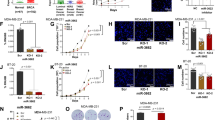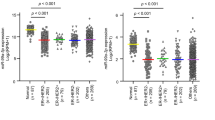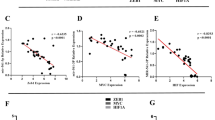Abstract
The human POK family members are transcription factors with a POZ domain and zinc-fingers that act primarily as transcriptional repressors. Several members of this family are involved in oncogenesis and this prompted us to assess whether expression levels of individual POK family members are associated with clinical outcomes in cancer. We have observed that ZBTB4 (zinc-finger and BTB domain containing 4) is downregulated in breast cancer patients, and that its expression is significantly correlated with relapse-free survival. Further integrative analysis of mRNA and microRNA (miR) expression data from the NCI-60 cell lines revealed an inverse correlation between ZBTB4 and oncogenic miRs derived from the miR-17-92 cluster and its paralogs. The experimental results using MDA-MB-231 and MCF-7 human breast cancer cells confirm that miRNAs derived from these clusters, containing miR-17-5p, miR-20a, miR-106a, miR-106b and miR-93, negatively regulate ZBTB4 expression. Overexpression of ZBTB4 or restoration of ZBTB4 by using an antagomir inhibit growth and invasion of breast cancer cells, and this effect is due, in part, to ZBTB4-dependent repression of the specificity protein 1 (Sp1), Sp3 and Sp4 genes, and subsequent downregulation of several Sp-dependent oncogenes, in part, through competition between ZBTB4 and Sp transcription factors for GC-rich promoter sequences. These results confirm that ZBTB4 functions as a novel tumor-suppressor gene with prognostic significance for breast cancer survival, and the oncogenic miR-17-92/ZBTB4/Sp axis may be a potential therapeutic target.
This is a preview of subscription content, access via your institution
Access options
Subscribe to this journal
Receive 50 print issues and online access
$259.00 per year
only $5.18 per issue
Buy this article
- Purchase on Springer Link
- Instant access to full article PDF
Prices may be subject to local taxes which are calculated during checkout







Similar content being viewed by others
References
Abdelrahim M, Baker CH, Abbruzzese JL, Sheikh-Hamad D, Liu S, Cho SD et al. (2007). Regulation of vascular endothelial growth factor receptor-1 (VEGFR1) expression by specificity proteins 1, 3 and 4 in pancreatic cancer cells. Cancer Res 67: 3286–3294.
Abdelrahim M, Samudio I, Smith R, Burghardt R, Safe S . (2002). Small inhibitory RNA duplexes for Sp1 mRNA block basal and estrogen-induced gene expression and cell cycle progression in MCF-7 breast cancer cells. J Biol Chem 277: 28815–28822.
Abdelrahim M, Smith III R, Burghardt R, Safe S . (2004). Role of Sp proteins in regulation of vascular endothelial growth factor expression and proliferation of pancreatic cancer cells. Cancer Res 64: 6740–6749.
Blenkiron C, Goldstein LD, Thorne NP, Spiteri I, Chin SF, Dunning MJ et al. (2007). MicroRNA expression profiling of human breast cancer identifies new markers of tumor subtype. Genome Biol 8: R214.
Blower PE, Verducci JS, Lin S, Zhou J, Chung JH, Dai Z et al. (2007). MicroRNA expression profiles for the NCI-60 cancer cell panel. Mol Cancer Ther 6: 1483–1491.
Cattoretti G, Pasqualucci L, Ballon G, Tam W, Nandula SV, Shen Q et al. (2005). Deregulated BCL6 expression recapitulates the pathogenesis of human diffuse large B cell lymphomas in mice. Cancer Cell 7: 445–455.
Chadalapaka G, Jutooru I, Burghardt R, Safe S . (2010). Drugs that target specificity proteins downregulate epidermal growth factor receptor in bladder cancer cells. Mol Cancer Res 8: 739–750.
Chadalapaka G, Jutooru I, Chintharlapalli S, Papineni S, Smith III R, Li X et al. (2008). Curcumin decreases specificity protein expression in bladder cancer cells. Cancer Res 68: 5345–5354.
Chen WY, Wang DH, Yen RC, Luo J, Gu W, Baylin SB . (2005). Tumor suppressor HIC1 directly regulates SIRT1 to modulate p53-dependent DNA-damage responses. Cell 123: 437–448.
Chen WY, Zeng X, Carter MG, Morrell CN, Chiu Yen RW, Esteller M et al. (2003). Heterozygous disruption of Hic1 predisposes mice to a gender-dependent spectrum of malignant tumors. Nat Genet 33: 197–202.
Costoya JA . (2007). Functional analysis of the role of POK transcriptional repressors. Brief Funct Genomic Proteomic 6: 8–18.
Dews M, Homayouni A, Yu D, Murphy D, Sevignani C, Wentzel E et al. (2006). Augmentation of tumor angiogenesis by a Myc-activated microRNA cluster. Nat Genet 38: 1060–1065.
Eisen MB, Spellman PT, Brown PO, Botstein D . (1998). Cluster analysis and display of genome-wide expression patterns. Proc Natl Acad Sci USA 95: 14863–14868.
Filion GJ, Zhenilo S, Salozhin S, Yamada D, Prokhortchouk E, Defossez PA . (2006). A family of human zinc finger proteins that bind methylated DNA and repress transcription. Mol Cell Biol 26: 169–181.
Fontana L, Fiori ME, Albini S, Cifaldi L, Giovinazzi S, Forloni M et al. (2008). Antagomir-17-5p abolishes the growth of therapy-resistant neuroblastoma through p21 and BIM. PLoS One 3: e2236.
He L, Thomson JM, Hemann MT, Hernando-Monge E, Mu D, Goodson S et al. (2005). A microRNA polycistron as a potential human oncogene. Nature 435: 828–833.
Inomata M, Tagawa H, Guo YM, Kameoka Y, Takahashi N, Sawada K . (2009). MicroRNA-17-92 down-regulates expression of distinct targets in different B-cell lymphoma subtypes. Blood 113: 396–402.
Jeon BN, Choi WI, Yu MY, Yoon AR, Kim MH, Yun CO et al. (2009). ZBTB2, a novel master regulator of the p53 pathway. J Biol Chem 284: 17935–17946.
Jeon BN, Yoo JY, Choi WI, Lee CE, Yoon HG, Hur MW . (2008). Proto-oncogene FBI-1 (Pokemon/ZBTB7A) represses transcription of the tumor suppressor Rb gene via binding competition with Sp1 and recruitment of co-repressors. J Biol Chem 283: 33199–33210.
Jutooru I, Chadalapaka G, Abdelrahim M, Basha MR, Samudio I, Konopleva M et al. (2010). Methyl 2-Cyano-3,12-dioxooleana-1,9-dien-28-oate (CDDO-Me) decreases specificity protein (Sp) transcription factors and inhibits pancreatic tumor growth: role of microRNA-27a. Mol Pharmacol 78: 226–236.
Koh DI, Choi WI, Jeon BN, Lee CE, Yun CO, Hur MW . (2009). A novel POK family transcription factor, ZBTB5, represses transcription of p21CIP1 gene. J Biol Chem 284: 19856–19866.
Kojima S, Hatano M, Okada S, Fukuda T, Toyama Y, Yuasa S et al. (2001). Testicular germ cell apoptosis in Bcl6-deficient mice. Development 128: 57–65.
Koutsodontis G, Moustakas A, Kardassis D . (2002). The role of Sp1 family members, the proximal GC-rich motifs, and the upstream enhancer region in the regulation of the human cell cycle inhibitor p21WAF−1/Cip1 gene promoter. Biochemistry 41: 12771–12784.
Krek A, Grun D, Poy MN, Wolf R, Rosenberg L, Epstein EJ et al. (2005). Combinatorial microRNA target predictions. Nat Genet 37: 495–500.
Lee SO, Abdelrahim M, Yoon K, Chintharlapalli S, Papineni S, Kim K et al. (2010). Inactivation of the orphan nuclear receptor TR3/Nur77 inhibits pancreatic cancer cell and tumor growth. Cancer Res 70: 6824–6836.
Lenz G, Wright G, Dave SS, Xiao W, Powell J, Zhao H et al. (2008). Stromal gene signatures in large-B-cell lymphomas. N Engl J Med 359: 2313–2323.
Lewis BP, Shih IH, Jones-Rhoades MW, Bartel DP, Burge CB . (2003). Prediction of mammalian microRNA targets. Cell 115: 787–798.
Li H, Bian C, Liao L, Li J, Zhao RC . (2011). miR-17-5p promotes human breast cancer cell migration and invasion through suppression of HBP1. Breast Cancer Res Treat 126: 565–575.
Liu H, D'Andrade P, Fulmer-Smentek S, Lorenzi P, Kohn KW, Weinstein JN et al. (2010). mRNA and microRNA expression profiles of the NCI-60 integrated with drug activities. Mol Cancer Ther 9: 1080–1091.
Liu S, Goldstein RH, Scepansky EM, Rosenblatt M . (2009). Inhibition of rho-associated kinase signaling prevents breast cancer metastasis to human bone. Cancer Res 69: 8742–8751.
Maeda T, Hobbs RM, Merghoub T, Guernah I, Zelent A, Cordon-Cardo C et al. (2005). Role of the proto-oncogene Pokemon in cellular transformation and ARF repression. Nature 433: 278–285.
Mertens-Talcott SU, Chintharlapalli S, Li X, Safe S . (2007). The oncogenic microRNA-27a targets genes that regulate specificity protein (Sp) transcription factors and the G2-M checkpoint in MDA-MB-231 breast cancer cells. Cancer Res 67: 11001–11011.
Nicolas M, Noe V, Jensen KB, Ciudad CJ . (2001). Cloning and characterization of the 5′-flanking region of the human transcription factor Sp1 gene. J Biol Chem 276: 22126–22132.
Niu H . (2002). The proto-oncogene BCL-6 in normal and malignant B cell development. Hematol Oncol 20: 155–166.
Oh DS, Troester MA, Usary J, Hu Z, He X, Fan C et al. (2006). Estrogen-regulated genes predict survival in hormone receptor-positive breast cancers. J Clin Oncol 24: 1656–1664.
Pendergrast PS, Wang C, Hernandez N, Huang S . (2002). FBI-1 can stimulate HIV-1 Tat activity and is targeted to a novel subnuclear domain that includes the Tat-P-TEFb-containing nuclear speckles. Mol Biol Cell 13: 915–929.
Perez-Torrado R, Yamada D, Defossez PA . (2006). Born to bind: the BTB protein-protein interaction domain. Bioessays 28: 1194–1202.
Sasai N, Nakao M, Defossez PA . (2010). Sequence-specific recognition of methylated DNA by human zinc-finger proteins. Nucleic Acids Res 38: 5015–5022.
Shankavaram UT, Reinhold WC, Nishizuka S, Major S, Morita D, Chary KK et al. (2007). Transcript and protein expression profiles of the NCI-60 cancer cell panel: an integromic microarray study. Mol Cancer Ther 6: 820–832.
Takeuchi T, Tomida S, Yatabe Y, Kosaka T, Osada H, Yanagisawa K et al. (2006). Expression profile-defined classification of lung adenocarcinoma shows close relationship with underlying major genetic changes and clinicopathologic behaviors. J Clin Oncol 24: 1679–1688.
Tapias A, Ciudad CJ, Noe V . (2008). Transcriptional regulation of the 5′-flanking region of the human transcription factor Sp3 gene by NF-1, c-Myb, B-Myb, AP-1 and E2F. Biochim Biophys Acta 1779: 318–329.
Tillotson LG . (1999). RIN ZF, a novel zinc finger gene, encodes proteins that bind to the CACC element of the gastrin promoter. J Biol Chem 274: 8123–8128.
van de Vijver MJ, He YD, van't Veer LJ, Dai H, Hart AA, Voskuil DW et al. (2002). A gene-expression signature as a predictor of survival in breast cancer. N Engl J Med 347: 1999–2009.
Volinia S, Calin GA, Liu CG, Ambs S, Cimmino A, Petrocca F et al. (2006). A microRNA expression signature of human solid tumors defines cancer gene targets. Proc Natl Acad Sci USA 103: 2257–2261.
Weber A, Marquardt J, Elzi D, Forster N, Starke S, Glaum A et al. (2008). Zbtb4 represses transcription of P21CIP1 and controls the cellular response to p53 activation. EMBO J 27: 1563–1574.
Yu Z, Wang C, Wang M, Li Z, Casimiro MC, Liu M et al. (2008). A cyclin D1/microRNA 17/20 regulatory feedback loop in control of breast cancer cell proliferation. J Cell Biol 182: 509–517.
Yu Z, Willmarth NE, Zhou J, Katiyar S, Wang M, Liu Y et al. (2010). microRNA 17/20 inhibits cellular invasion and tumor metastasis in breast cancer by heterotypic signaling. Proc Natl Acad Sci USA 107: 8231–8236.
Acknowledgements
This research was supported by the National Institutes of Health (CA136571) and is gratefully acknowledged. PAD is supported by Association pour la Recherche sur le Cancer, Ligue contre le Cancer and Institut National du Cancer. DY was supported by a postdoctoral fellowship from Association pour la Recherche sur le Cancer.
Author information
Authors and Affiliations
Corresponding author
Ethics declarations
Competing interests
The authors declare no conflict of interest.
Additional information
Supplementary Information accompanies the paper on the Oncogene website
Supplementary information
Rights and permissions
About this article
Cite this article
Kim, K., Chadalapaka, G., Lee, SO. et al. Identification of oncogenic microRNA-17-92/ZBTB4/specificity protein axis in breast cancer. Oncogene 31, 1034–1044 (2012). https://doi.org/10.1038/onc.2011.296
Received:
Revised:
Accepted:
Published:
Issue Date:
DOI: https://doi.org/10.1038/onc.2011.296
Keywords
This article is cited by
-
Identification of ZBTB4 as an immunological biomarker that can inhibit the proliferation and invasion of pancreatic cancer
BMC Cancer (2023)
-
BTB protein family and human breast cancer: signaling pathways and clinical progress
Journal of Cancer Research and Clinical Oncology (2023)
-
miRNA-576-5p promotes endometrial cancer cell growth and metastasis by targeting ZBTB4
Clinical and Translational Oncology (2022)
-
Regulation of DNA methylation machinery by epi-miRNAs in human cancer: emerging new targets in cancer therapy
Cancer Gene Therapy (2021)
-
Post-transcriptional regulation of MMP2 mRNA by its interaction with miR-20a and Nucleolin in breast cancer cell lines
Molecular Biology Reports (2021)



